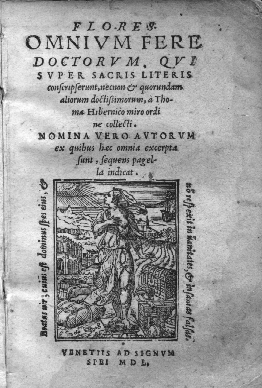The 1483 Piacenza Edition
The Rouses (Preachers, p.182) determined that this first printed edition of the Manipulus florum contains 47 entries under 16 topics that are not found in the earliest manuscripts. They suggested that these additiones were probably not inserted by the printer, Jacobus de Tyela, but rather were perpetuated by him from his unknown source manuscript.
This website provides a searchable edition of the Piacenza additiones compiled in 2007 by the editor with the assistance of Ms. Elena Crupi, an MA student in the Tri-University History Program at Wilfrid Laurier University.
______________________________
The 1550 Venice Edition
Using funds provided by the WLU Research Office, a copy of this edition of the Manipulus was purchased in 2004 to be used in collating variants for the critical edition. The book was later donated to the WLU Library.
The Rouses (Preachers, p.182) pointed out that the anonymous editor of this 1550 edition introduced four changes that were perpetuated in all subsequent editions:
1) The title was changed from Manipulus florum to Flores omnium fere doctorum…. Subsequent editions would employ a variant on this title, most commonly Flores omnium pene doctorum….
2) Thomas' Preface (inc. "Abiit in agrum…") was replaced with a new letter to the reader (inc. "Typogryphus lectori candido salutem…").
3) A list of authors was added at the front of the volume.
4) The topics Christianus and Christus were moved from the end of the collection to the appropriate place among the topics beginning with 'C'.
In addition, the term used by Thomas to introduce the list of cross-references at the end of topics ("Vbi") was replaced with the phrase "Vide etiam in titulis"; this alteration was also perpetuated in subsequent editions.
The editor of this 1550 edition also removed the so-called "dummy entries" from the text itself, though they were retained in the list of topics which serves as a table of contents. These are topic headings without any quotations that Thomas included to refer readers to actual topics; for example, in the manuscripts and both of the incunable editions, between the end of Periculum and the beginning of Perseuerancia, the following reference is found: "Periuria ubi Iuramentum". Thus, Thomas indicates to readers that there is no lemma for perjury, but relevant quotations are found under the lemma on oath swearing.
Finally, the Venetian editor also deleted a number of quotations, some of which were repeated elsewhere in the original collection.
The most important aspect of the 1550 Venice edition was discovered during the edition project.
Editorial Agency in the 1550 Edition
The unknown editor of the 1550 Venice edition was quite active in attempting to ameliorate the received text in what was surely this edition's exemplar: the 1493/5 Venice edition. In most cases this intervention in the textual tradition involved correcting perceived typographical or grammatical errors, as seen for example in Scriptura sacra as; and in a few cases only the attribution of a quotation was corrected, as seen in Passio ae. But in other cases this editor intervened much more actively.
As of 12 July 2013 the following 48 entries had been identified in which the text in the 1550 Venice edition is significantly closer to the original source than the version in the 1493/95 edition, and often closer than the original text of the Manipulus as well. There are also a few cases in which the editor of the 1550 edition filled in lacunae or extended the quotation to include lines not found in the manuscripts and the two previous printed editions.
Ambrose of Milan (3): Liberalitas i; Verecundia a, Verecundia d.
Augustine of Hippo (4): Peccatum n; Religio b, Religio c, Religio d.
Bernard of Clairvaux (12): Passio ac; Perseuerancia c; Relinquere u, Relinquere x, Relinquere y; Spiritus sanctus q; Trinitas f, Trinitas g; Voluntas i, Voluntas z, Voluntas ac, Voluntas ae.
Gregory the Great (6): Predicacio ac; Sapiencia siue sciencia l, Sapiencia siue sciencia m; Scriptura sacra an; Temptatio q; Tribulatio ag.
Isidore of Seville (7): Oratio bc, Oratio bd, Oratio bg, Oratio bi; Peccatum am; Sortilegium et diuinatio a; Testimonium c.
John Cassian (6): Oratio bo; Relinquere ae/af, Relinquere ag, Relinquere ah, Relinquere ai, Relinquere ak.
Marcus Tullius Cicero (1): Libertas g.
Peter of Blois (2): Milicia t, Milicia ac.
Peter Chrysolaras (1): Sanctitas uel sanctus r.
Pliny the Elder (2): Homo m, Homo o.
Valerius Maximus (1): Taciturnitas p.
Vegetius Renatus (3): Milicia i, Milicia k, Milicia l.
The editorial methodology for these documents is intended to highlight textual differences between the two Venice editions in relation to the standard modern edition of the text. Cases of amelioration in the 1550 edition are indicated by single-line underscoring; cases in which the 1550 edition varies from both the 1493/5 edition and the standard modern edition are indicated by double-line underscoring.
______________________________
The 1567 Lyon Edition
While the 1550 Venice edition did introduce a number of formal and structural changes to the Manipulus, as well as emending the texts of a number of quotations, its contents in terms of the actual quotations provided remained relatively stable. But the edition published by Thibault Payen at Lyons in 1567 marks a new phase in its early print history as this editor integrated over 400 new quotations under most of the existing topics, marking most of the additions with an asterix, and also added a new topic, Animal brutum, containing seven quotations of its own.
In the process of collating this edition it became apparent that in the first gathering of his print run Payen inserted twenty-six new quotations into four topics that were not indicated with an asterix, and instead were integrated into the letter referencing scheme: Adulacio (2), Ambicio (1), Amicicia (10), and Amor (13). Thus, the last quotation under Amicicia in the critical edition is designated 'dk', but in the 1567 edition it is 'du'. Because they were not simply added at the end but were inserted into the section of quotations by the cited author, this practice corrupted the cross-referencing scheme developed by Thomas of Ireland with respect to those topics. After printing the first gathering Payen apparently realized the negative effect of this practice on the cross-references and so discontinued it; for the rest of the book he employed asterixes to mark additional quotations and did not alter the letter designations for following quotations.
Called by Rouses (Preachers, p.184) the first of the "enlarged" editions, Payen's 1567 edition became the ultimate source for most subsequent editions, most of which would perpetuate his system of marking the additional quotations with asterixes; they also perpetuated the added quotations that were not indicated by an asterix, and which continued to disrupt the cross-referencing system for the affected topics.
This website provides a searchable edition of Payen's additiones which was compiled by the editor with the assistance of two graduate students in the Tri-University History Program at Wilfrid Laurier University: Jason Sager (2003, 2005) and Nicholas Must (2007). It contains the 450 quotations that are indicated by asterixes and also the twenty-six that are not.



